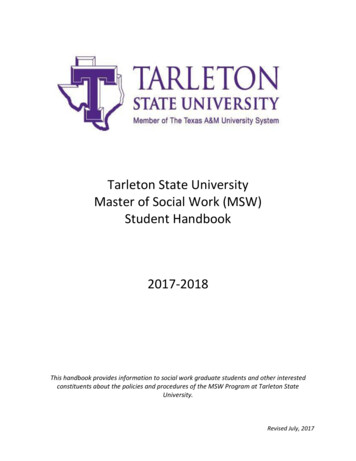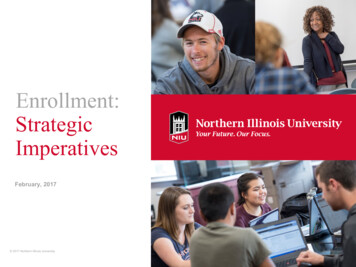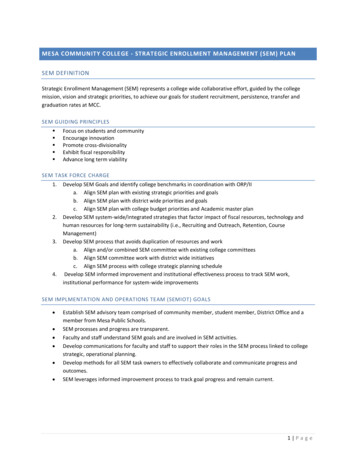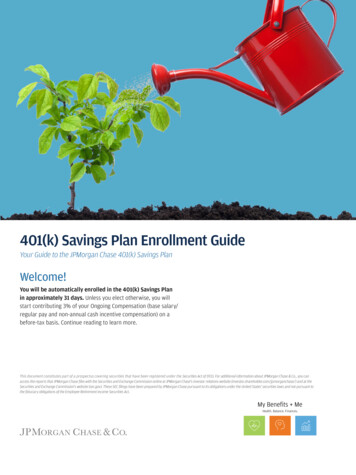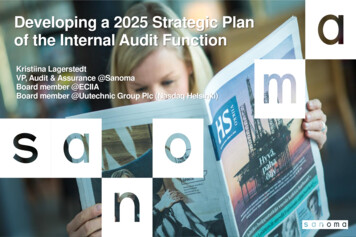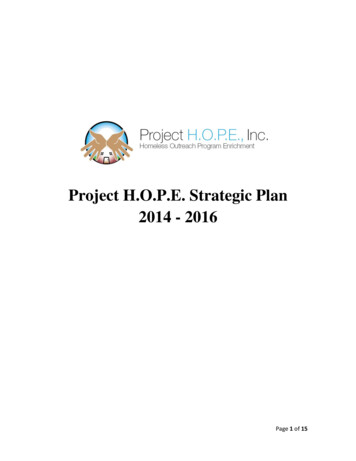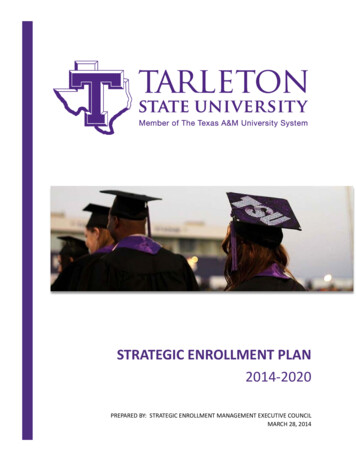
Transcription
STRATEGIC ENROLLMENT PLAN2014-2020PREPARED BY: STRATEGIC ENROLLMENT MANAGEMENT EXECUTIVE COUNCILMARCH 28, 2014
Tarleton State UniversitySTRATEGIC ENROLLMENT PLANNING PARTICIPANTSStrategic Enrollment Management Executive CouncilMr. Harry Battson, Assistant Vice President, MarketingDr. Jennifer Edwards, Assistant Vice President, Student Success & Multicultural InitiativesMs. Becky Gray, Executive Director for Information Technology Services & Chief InformationOfficerDr. Mike Haynes, Executive Director, Institutional Research (ex officio)Mr. Rusty Jergins, Vice President, Student LifeMs. Lisa Lewis, Senior Manager, Student Account ServicesDr. Linda Jones, Dean, College of Graduate StudiesDr. Marilyn Robitaille, Director of International Programs & Associate Professor, English &LanguagesDr. Kim Rynearson, Assistant Vice President, Outreach & Off-Campus ProgramsDr. Mark Shipman, Faculty Senate President & Professor, English and LanguagesDr. Diane Taylor, Assistant Vice President, Academic Programs & AccreditationDr. David Weissenburger, Associate Vice President, Enrollment Management (chair)Recruitment Functional TeamMs. Betti Cryer, Program Coordinator, Honors CollegeMs. Cindy Hess, Director, Undergraduate AdmissionsDr. Barry Lambert, Associate Dean, College of Graduate StudiesMs. Rachel Lawson, Coordinator of Transfer Services, Undergraduate AdmissionsDr. Marilyn Robitaille, Director of International Programs & Associate Professor, English &LanguagesDr. Kim Rynearson, Assistant Vice President, Outreach & Off-Campus Programs (chair)Retention, Progression, & Completion Functional TeamMr. Michael Barnette, Coordinator, Transition & Family RelationsMs. Darla Doty, Assistant Vice President, Student LifeDr. Jennifer Edwards, Assistant Vice President, Student Success & Multicultural InitiativesMr. Rusty Jergins, Vice President, Student Life (chair)Dr. Linda Jones, Dean, College of Graduate StudiesDr. Karen Murray, Executive Vice President & Provost, Academic AffairsDr. James Pierce, Dean, College of Science & TechnologyDr. Dwayne Snider, Associate Vice President, Academic Affairs AdministrationDr. Elizabeth Wallace, Student Assessment Specialist, Student Life StudiesDr. David Weissenburger, Associate Vice President, Enrollment ManagementAcademic Program Stimulation Functional TeamDr. David Drueckhammer, Associate Dean & Professor, College of Agricultural & EnvironmentalSciencesDr. Nate Heller, Assistant Dean & Assistant Professor, College of Business AdministrationDr. Linda Jones, Dean, College of Graduate StudiesDr. Mark Shipman, Faculty Senate President & Professor, English and LanguagesDr. Diane Taylor, Assistant Vice President, Academic Programs & Accreditation (chair)2014-2020STRATEGIC ENROLLMENT PLAN1
Tarleton State UniversityMarketing Functional TeamMr. Harry Battson, Assistant Vice President, Marketing (chair)Dr. Anthony Edwards, Assistant Professor & Director of E-Campus & Online DegreesMr. Carlos Figueroa, Program Coordinator, International Programs & Study AbroadMs. Daphne Hunt, University Web Administrator, Web ServicesDr. Linda Jones, Dean, College of Graduate StudiesDr. Kim Rynearson, Assistant Vice President, Outreach & Off-Campus ProgramsPast ParticipantsDr. Cynthia Carter, Assistant Vice President, Strategic InitiativesDr. Credence Baker, Certification Officer & Assistant Professor, Curriculum & InstructionMs. Laurie Gaiser, Director, School Relations & Welcome CenterMs. Janice Horak, Assistant Vice President, Marketing & CommunicationsDr. Rickey Richardson, Senior Vice President, Advancement & External RelationsDr. Ashley Tull, Assistant Vice President, Student Life Studies2014-2020STRATEGIC ENROLLMENT PLAN2
Tarleton State UniversityTABLE OF CONTENTSIntroduction and Executive Summary 4Organizational Structure . 5Situation Analysis . 8SWOT Analysis . 8Demographic Trends 10Competition . 12Admissions Trends . 14Enrollment Projections . 15Market Share & Target Markets . 17Retention/Progression/Completion Data . 21Institutional Mission, Vision, Core Values, and Goals 23Key Performance Indicators and Planning Assumptions . 24Key Performance Indicators . . 24Planning Assumptions . 26Strategies and Priorities for Action 27Recruitment 27Retention, Progression, and Completion . 33Academic Program Stimulation 36Marketing . 37Enrollment Goals . 38Summary . 402014-2020STRATEGIC ENROLLMENT PLAN3
Tarleton State UniversityINTRODUCTION AND EXECUTIVE SUMMARYTarleton State University is committed to providing an academically challenging education to thecitizens of Texas and beyond. It supports the success of each student and seeks to provide a premierstudent-focused environment.Tarleton realizes that it can no longer rely on enrollment by chance to reach its long-term enrollmentgoals. Today, the university recognizes that volatility is the new norm in both the higher educationenvironment and the availability of resources needed to accomplish its vision and mission. Itrecognizes the changing demographics, preparation, employment market, overall economic conditions,and needs of an increasingly diverse body of learners that are both traditional and non-traditional.Competition to attract students is greater than ever among colleges and universities as the numbers ofstudents in traditional cohorts decline and inventive higher educational models such as for-profit,online, and MOOCs draw students away.For these reasons Tarleton has developed a strategic enrollment plan that is intentional and uses adata-informed approach for meeting the university’s enrollment goals. It is an enrollment by designapproach aligned with the university’s strategic plan. It is meant to guide the university towardoptimum enrollment as defined within the context of fulfilling the institutional mission. Attractingstudents that are most likely to succeed at Tarleton and then providing support for their success is atop priority.The strategic enrollment plan and its strategies fall into four separate yet interconnected dimensions:recruitment, marketing, academic program stimulation, and retention, progression, and completion (orstudent success). Undergraduate and graduate student groups, academic and nonacademic areas, andon-campus and off-campus locations are all given consideration. Implementation of the plan requiresinvolvement of each division at the university.The strategic enrollment plan is linked to Texas A&M University System metrics that have beenestablished for Tarleton. Historical enrollment data and goals for recruiting, progression, andgraduation up to the year 2020, in addition to the strategies and measures within the university’sstrategic plan, helped to guide the development of the strategic enrollment plan’s goals and strategies.By 2020, the goals include:o Enroll 15,000 students across all campus locationso 10,000 students at Stephenville campus (undergraduate & graduate)o 5,000 students at outreach campuses and online (undergraduate & graduate)o Achieve a 75% retention rate from freshman to sophomore yearo Achieve a 44% 6-year graduation rateo Achieve Hispanic Serving Institution status (25% undergraduate student FTE)o Enroll 2,500 first-time in college studentso Enroll 12,000 undergraduate studentso Enroll 3,000 graduate studentso Enroll 350 international students2014-2020STRATEGIC ENROLLMENT PLAN4
Tarleton State UniversityORGANIZATIONAL STRUCTUREStrategic Enrollment Management Executive Council (SEMEC)The Strategic Enrollment Management Executive Council (SEMEC) serves as an oversight body that setsthe direction of enrollment management at Tarleton. It develops, annually reviews, and revises asneeded a strategic enrollment plan (SEP) that focuses on student success. The SEP integrates theuniversity’s recruitment, retention, marketing, and programmatic offerings to support the university’smission, strategic plan and long-term goals. An annual report on SEP outcomes is produced. SEMECreports to the Executive Cabinet.MembershipChair: Associate Vice President for Enrollment ManagementEx-Officio: Executive Director of Institutional ResearchMembers: 11, (excluding the chair and ex-officio) representing each division of the universityand the full-time facultyTerm of Office for Members: 3 yearsMembership is appointed by the PresidentSpecified Meeting DatesOnce a quarter or more often as necessarySubcommitteesSEMEC determines the need for functional teams and appoints membership of those teams.The chair of each team is a member of SEMEC but the team members do not necessarily needto be members of SEMEC. The 4 core functional teams align with the 4 dimensions of the SEPand include:ooooRecruitmentMarketingAcademic Program StimulationRetention, Progression, and CompletionFunctional teams may appoint ad hoc task forces or working groups to support their initiatives.SEMEC empowers its functional teams to take actions that are consistent with the mission andstrategic plan of the university. Progress reports and activities of functional teams will bereported by team chairs to SEMEC at its quarterly meeting.It is the responsibility of SEMEC to monitor implementation of the SEP.2014-2020STRATEGIC ENROLLMENT PLAN5
Tarleton State UniversityStrategic Enrollment Management Executive CouncilStructureMarketingRecruitmentStrategic EnrollmentManagementExecutive Progression,& CompletionDATACOMMUNICATION2014-2020STRATEGIC ENROLLMENT PLAN6
Tarleton State UniversityStrategic Enrollment Management Workflow ProcessPresident bcommitteeor Task ForceFunctional Teams:2014-2020Marketing; Recruitment; Academic Program Stimulation; andRetention, Progression, and CompletionSTRATEGIC ENROLLMENT PLAN7
Tarleton State UniversitySITUATION ANALYSISStrengths, Weaknesses, Opportunities, and Challenges Analysis - 2012 SEMEC Survey ResultsStrengthsExisting characteristics – physical, human, and financial – that clearly contribute to institutional successand the achievement of enrollment goalsooooooooComprehensive programmatic offeringsAffordabilityClass sizeNationally accredited programsCampus securityAcademic advisingStudy abroad opportunitiesLibrary resourcesWeaknessesExisting characteristics – both internal and external – that detract from institutional success and theachievement of enrollment goalsoooooooooooAcademic profile/preparednessNeed more STEM programsLittle scholarship/merit financial aid (institutional)Faculty/staff salariesGrowth challengeso Reliance on adjunctso On-campus housing shortageo Insufficient sections of classes offeredOnline/international studentsRetention/completion/timely graduationCourse offerings/times/lack of coordinationCredit hours enrolled by students each semesterTechnologyTexas A&M – Central Texas dependence/relationship2014-2020STRATEGIC ENROLLMENT PLAN8
Tarleton State UniversityOpportunitiesInternal and external factors that have the potential to be developed into strengthsoooooooooooGrowth in programs (health sciences, etc.)Extended site/graduate/online program expansionPotential PhD programsGrow honors programExternal funding - giving/foundations/governmentStudent engagementRetention focusEfficiencies/collaborationApplied learning opportunitieso Service learningo Undergraduate researcho Study abroado Internshipso ationsPromoting smart choices by studentsThreatsInternal or external conditions that are obstacles to institutional success and achievement of enrollmentgoalsooooooooooooUnfunded mandates by state and systemDiminished student financial aidCompetition for students from other re-packaged programs/MOOCsLabor pool for replacing retirement age facultyPublic perception of higher education: heightened/negativeo Student attitudes toward collegeo The commoditization of higher educationo Consumerism mentality of parents and studentso Entitlement cultureAccreditation agency/professional association requirementsDynamic change/movements in the landscape of higher educationo Increase of for-profit institutionso Changing role of regional state institutionsPolitics of higher education (system/state/national levels)Changing technologyFaculty/staff compensationState funding cuts/decreases2014-2020STRATEGIC ENROLLMENT PLAN9
Tarleton State UniversityDemographic TrendsAccording to a Texas Higher Education Coordinating Board report issued in October 2013, U.S.Department of Education data show a 1.8% decline in higher education enrollment from fall 2011 to fall2012. This follows a decline of .2% from the previous year. In Texas, total enrollments at Texas publicuniversities continued to outperform the national average and showed an increase of 1.79% students infall 2013 when compared to fall 2012. Texas is likely to continue this trend and enroll more studentsthan the national average in the future because of demographic changes across the U.S.Table 1 presents the Western Interstate Commission for Higher Education (WICHE) projections for Texashigh school graduates. A WICHE report (December 2012) notes that Texas can expect swift expansion inthe number of students while other areas of the country such as the Midwest and Northeast willexperience significant shrinkage. From the 2008-09 school year to the 2019-20 school year, the nation’spublic schools will produce:ooooo12% fewer White non-Hispanic graduates41% more Hispanic graduates30% more Asian/Pacific Islander graduates9% fewer Black non-Hispanic graduates2% more American Indian/Alaskan Native graduatesIn anticipation of this trend, the Texas Higher Education Coordinating Board (THECB) developed theClosing the Gaps initiative in 2000 to increase overall participation in higher education, increaseminority student enrollment, and encourage students to major in certain fields such as science,technology, engineering and math in Texas colleges and universities.Participation for all identified demographic groups increased by 66% from 2000 to 2012 at Tarleton. Thetotal number of students in fall 2012 was 10,279 compared to 6,210 students in fall 2000. Tarleton alsobecame more diverse during this period. In 2012, 25% of the student body was a person of colorcompared to only 11% in 2000. The number of non-white students increased 295% from 2000 to 2012.First time in college admitted students for fall 2012 were 29% non-white. More female students thanmale students are applying to Tarleton and this is consistent with a national trend. The student body iscurrently 60% female.Tarleton has also experienced an expansion in the number of applicants from different regions of Texas,particularly from the urban areas located in the eastern 2/3 of the state. In fall 2010, first time incollege applicants came from 820 different high schools in Texas; in fall 2013 they came from 1,337different schools. Transfer applicants came from 230 different colleges and universities in fall 2010; infall 2013 they came from 313 different colleges and universities.2014-2020STRATEGIC ENROLLMENT PLAN10
Tarleton State UniversityTable 1 – WICHE Projections of Texas High School GraduatesPUBLIC BY RACE/ETHNICITYAmerican Indian/ Asian/PacificBlack nonAlaska MICYEARRACE/ETHNICITYTOTALNONPUBLICTOTALPUBLIC 89,036330,18115,460345,642White nonHispanicPUBLICTOTALNotes: The “Race/Ethnicity Total” column is the sum of the five racial/ethnic group columns. It will not equal the “Public Total” column in the projected years and also may notfor the years in which actual data are reported if the state collects data on additional racial/ethnic groups. Beginning 2008-09, Native Hawaiians that were reported separatelywere added to the Asian/Pacific Islander category here, and multiracial individuals were distributed among the four race categories. See Appendix B for details about the sourcedata and Chapter 4 for the projection methodology.2014-2020STRATEGIC ENROLLMENT PLAN11
Tarleton State UniversityCompetitionTarleton State University Applicants –Other Colleges and Universities Receiving the Most SAT Score Reports (in rank order)1.2.3.4.5.6.7.8.9.10.Texas A&M University – College StationTexas State University – San MarcosUniversity of North TexasTexas Tech UniversityStephen F. Austin State UniversityUniversity of Texas at ArlingtonSam Houston State UniversityBaylor UniversityTexas Christian UniversityAngelo State UniversityTarleton State University Applicants –Other Colleges and Universities Receiving the Most Texas Common Applications (in rank order)1.2.3.4.5.6.7.8.9.10.Texas State University – San MarcosStephen F. Austin State UniversityTexas A&M University – College StationTexas Tech UniversityUniversity of North TexasSam Houston State UniversityUniversity of Texas at ArlingtonAngelo State UniversityUniversity of Texas at San AntonioTexas A&M University – Corpus ChristiTarleton State University Applicants –Other Colleges and Universities Attended by Admitted Applicants (in rank order)1.2.3.4.5.6.7.8.9.10.Texas Tech UniversityTexas State University – San MarcosTexas A&M University – College StationTarrant County CollegeStephen F. Austin State UniversityBlinn CollegeTexas
needed a strategic enrollment plan (SEP) that focuses on student success. The SEP integrates the university’s recruitment, retention, marketing, and programmatic offerings to support the university’s mission, strategic plan and long-term goals. An annual report on SEP outc
